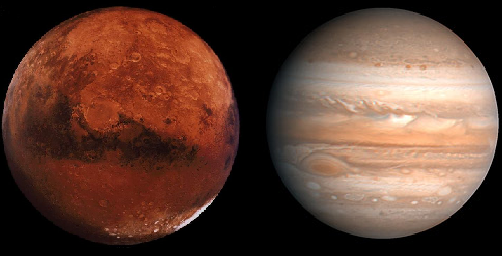As promised, on the first Sunday of each month I’ll be posting things for you to see in the night sky in the coming month. This is aimed at naked eye astronomers, those of us without any equipment, but at the bottom of the page, there’s a link to a monthly review with things you can see with equipment. Get your coat, and your star map, and have an explore!
Planets
Mars and Jupiter, as well as the usual vision of pre morning/post sunset loveliness that is Venus, are visible this month. Jupiter is high in the sky and is brighter than Sirius (the brightest star), so if it is the brightest thing you can see, and is not flashing, twinkling or moving, then it’s going to be Jupiter.
April 8th – Mars is in opposition (a straight line between the Sun and Earth), an event that is happening every 26 months.
April 14th – After sunset, Mars will appear very bright (as bright as Sirius) just above the nearly full moon and will be closest to us in its orbit, so look out for that!
You’ll notice that Mars and Jupiter lie on the same curve if you link them up- That’s the ecliptic. Almost all the planets (Mercury has an unusual orbit) and the Sun lie on this, and it shows the plane of the Solar system. If you’re ever looking for a planet, it’ll be hanging out on that imaginary line.
ISS

Maximilian Teodorescu caught the ISS in front of the sun. Amazing. Source: http://kottke.org/13/07/iss-in-transit
The International space station orbits the Earth every 90 minutes. It is going to be passing over the UK a few times this month, (it’ll be coming over my town on my birthday!) so find out if it is coming over your city and how long you’ve got to see it by using the ISS spotter website, found on my Astronomy & Space page. Naked eye astronomers, I don’t think we’ll see more than a bright, fast moving dot.
Moon
April 15th – Full moon
Also on this day, according to space.com, Aussies, Kiwis and co will get a lunar eclipse:
Earth’s shadow will darken the moon in a total lunar eclipse visible throughout North and South America, Australia, New Zealand and other parts of the Pacific region.
Totality will last from 3:07 a.m. until 4:25 a.m. EDT (0707-0825 GMT), while partial phases of the eclipse will be visible for a few hours before and after this stretch.
For a much, much more comprehensive guide, check out Jodrell Bank’s run through of this month, including things you can see with binoculars and telescopes here.
Stay tuned this month as I’m hitting the ground running, tackling questions like
“Why is the sky blue?”
“Why do stars twinkle?”
and have a monthly ‘Astronomical Feature in Focus’, this month’s will be the constellation of Orion, because it holds a staggering range in the life stages and types of the stars.



Stunning pictures!! I walk the nights sometimes and just can’t help but gaze at the heavens above. I remember when i was 10 in 1999 and I saw the first solar eclipse — stunning. x
I can’t get enough of them, wish I had a telescope able to take these kinds of images. I saw that too, we sat in a field with those funny glasses on watching, I loved how everything stopped, even the birds 🙂 Think I was 9!